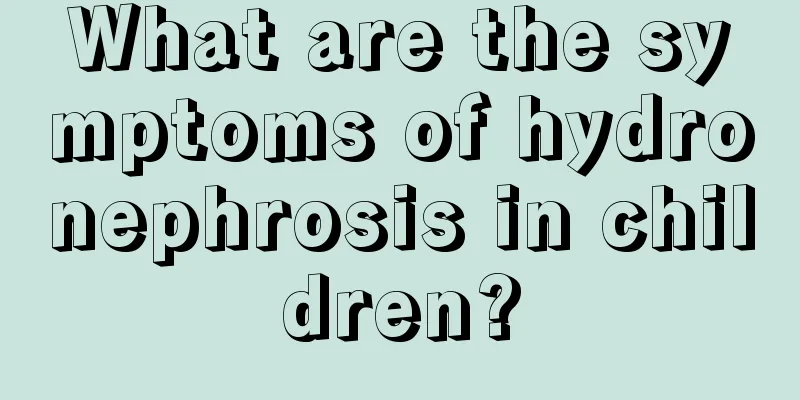What are the symptoms of hydronephrosis in children?

|
Hydronephrosis in children is also a common kidney disease in children during their growth period. There are many causes of hydronephrosis, which is generally caused by congenital or acquired kidney diseases. Children with hydronephrosis will easily show symptoms of abdominal pain, vomiting, abdominal distension, etc., especially after drinking water, the symptoms will be more severe due to urethral tube blockage. Symptoms of hydronephrosis in children Hydronephrosis is not good for the kidney health of babies. It can easily cause more pain to the children and harm their health. The children's digestive tract will show more obvious symptoms because the occurrence of hydronephrosis will lead to the obstruction of urine excretion, causing abdominal distension, abdominal pain, vomiting, nausea and other symptoms. Especially after drinking a lot of water, the above symptoms will be significantly aggravated, causing pain to the baby. After the baby becomes ill, the urine will change. Generally, oliguria, polyuria, and hematuria will occur alternately. Symptoms of microscopic hematuria may occur, and concurrent infection may occur. For some children, the lump will suddenly shrink and the pain will be significantly relieved after a large amount of urination. The decrease in urine volume will cause the lump to increase and aggravate the symptoms of pain. Children are prone to lumps in the waist and abdomen. The lumps mostly occur below the ribs and gradually extend to the lateral abdomen and waist. Severely ill children often have cystic lumps with smooth surfaces and particularly regular edges. They are prone to fluctuations and the tenderness is not obvious. Mothers should be alert to hydronephrosis and need to fully understand the symptoms of the disease and actively treat the baby after the onset of the disease. Hydronephrosis is mainly caused by two diseases : 1. Ureteral obstruction: This is a common disease that causes hydronephrosis in the kidney. The reason is that a small section of the ureter becomes narrow and causes obstruction, which makes it difficult for urine in the kidney to flow to the bladder and stagnate in the kidney. Usually, hydronephrosis can be improved by simply removing a narrow section of the ureter and reconnecting it to keep the ureter open. 2. Urine reflux: Under normal circumstances, urine flows from the kidneys through the ureters to the bladder and then is excreted from the body; urine reflux is an abnormal phenomenon in which urine flows back from the bladder into the ureters and even flows back into the kidneys. At this time, the kidneys will have urine ready to flow into the bladder, as well as urine flowing back from the bladder. At this time, there will be too much water in the kidneys, causing hydronephrosis. Diagnosis Congenital hydronephrosis in children is mainly caused by congenital ureteropelvic junction obstruction. The incidence rate is approximately 0.13% to 0.16%. This disease is more common in males, and the lesions are mostly on the left side. In newborns, about 2/3 of the lesions are on the left side, and the incidence of bilateral lesions is 10% to 40%. This disease can be seen in all age groups from fetus to postnatal age, and about 25% occurs within 1 year old. In children with hydronephrosis, the amount of water accumulated can range from 50 ml to hundreds of milliliters, or even thousands of milliliters. The expansion of the renal collecting system can cause elongation of the renal medullary vessels and compression and ischemia of the renal parenchyma, and the renal tissue gradually atrophies and hardens, resulting in irreversible renal function. The younger the age and the more severe the obstruction, the more severe the hydronephrosis and the greater the harm, so early diagnosis and reasonable treatment are very necessary. 1. Clinical symptoms: Newborns and infants mostly come to the hospital with gastrointestinal discomfort and abdominal masses (accounting for more than half of them). Older patients are more likely to present with intermittent low back and abdominal pain, hematuria, urinary tract infection, etc. Renal rupture is occasionally seen. Children with severe hydronephrosis may have hypertension and uremia. 2. Make full use of biochemical, immunological and other laboratory techniques in clinical diagnosis and treatment: With the improvement of various invasive examination techniques and the expansion of the scope of sampling, the comprehensive use of advanced sensitive immunological and molecular biological techniques in the diagnosis and treatment of hydronephrosis shows good application prospects. |
>>: What should I do if my baby has a bad temper?
Recommend
What are the benefits of skipping rope for young children?
Thinking back to my childhood, the game I played ...
The importance of fundus examination in premature infants
Fundus examination of premature infants is a part...
Why does my child always have nosebleeds?
After seeing their children bleeding from the nos...
What to eat is good for children's heart
The heart is an important organ of the human body...
What to do if your newborn baby always chokes when eating milk
Generally speaking, if a newborn baby chokes occa...
Can a seven-month-old baby eat taro?
We all know that babies need to add complementary...
Introduction to infantile miliaria
Babies are something we should pay more attention...
What to do if your child coughs and has yellow phlegm
Coughing is a common symptom. The occurrence of t...
What are the disadvantages of children staying up late
Staying up late is a behavior that many people do...
What to do if your five-year-old baby is grinding his teeth
Teeth grinding in a five-year-old baby is a big p...
How long does it take to get menstruation after giving birth?
After giving birth, women must take comprehensive...
Neonatal thyrotropin method
You may not be very familiar with the method of u...
Causes of black tongue coating in children
The color of the tongue coating is generally whit...
What should parents do if their children have poor academic performance?
Children’s studies are what parents care about mo...
What should I do if my three-year-old baby has urticaria?
Before the baby is five years old, the body's...









